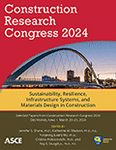River Flood Prediction Based on Physics-Informed Long Short-Term Memory Model
Publication: Construction Research Congress 2024
ABSTRACT
Flooding is one of the major natural disasters. Predicting river water levels and flooding is an effective way of enabling proactive flooding response measures. Although machine learning-based prediction models in prior studies have obtained a low error rate, they do not perform well during the rapid and significant water level rising (i.e., flooding). To provide a better flooding prediction tool, the present study first evaluates the commonly used long short-term memory model and points out the limitation of prior studies. Then, a novel model named physics-informed (PI) LSTM is proposed. The PI-LSTM integrates hydrological knowledge into the neural network as well as extends the current physics-informed river water level prediction neural networks to a recurrent one. Compared with LSTM, PI-LSTM has a better performance in predicting rapid and significant water level rising. The study is expected to increase the accuracy of flooding prediction and provide better decision-making support to agencies responsible for flood forecasting and warning.
Get full access to this article
View all available purchase options and get full access to this chapter.
REFERENCES
Albano, R., A. Sole, J. Adamowski, and L. Mancusi. 2014. “A GIS-based model to estimate flood consequences and the degree of accessibility and operability of strategic emergency response structures in urban areas.” Natural Hazards and Earth System Sciences. 14 (11), 2847–2865. https://doi.org/10.5194/nhess-14-2847-2014.
Bertels, D., and P. Willems. 2023. “Physics-informed machine learning method for modelling transport of a conservative pollutant in surface water systems.” Journal of Hydrology. 619 (March), 129354. https://doi.org/10.1016/j.jhydrol.2023.129354.
Biswas, R. K., and A. W. Jayawardena. 2014. “Water level prediction by artificial neural network in a flashy transboundary river of Bangladesh.” Global Nest Journal. 16 (2), 432–444. https://doi.org/10.30955/gnj.001226.
Dong, S., A. Esmalian, H. Farahmand, and A. Mostafavi. 2020. “An integrated physical-social analysis of disrupted access to critical facilities and community service-loss tolerance in urban flooding.” Computers, Environment and Urban Systems. 80 (October 2019), 101443. Elsevier. https://doi.org/10.1016/j.compenvurbsys.2019.101443.
Feng, D., Z. Tan, and Q. He. 2022. “Physics-informed neural networks of the Saint-Venant equations for downscaling a large-scale river model.” Water Resources Research. 59 (2), e2022WR033168.
Green, D., et al. 2017. “City-scale accessibility of emergency responders operating during flood events.” Natural Hazards and Earth System Sciences. 17 (1), 1–16. https://doi.org/10.5194/nhess-17-1-2017.
Leahy, P., G. Kiely, and G. Corcoran. 2008. “Structural optimisation and input selection of an artificial neural network for river level prediction.” Journal of Hydrology. 355 (1–4), 192–201. https://doi.org/10.1016/j.jhydrol.2008.03.017.
Leiteritz, R., M. Hurler, and D. Pfluger. 2021. “Learning Free-Surface Flow with Physics-Informed Neural Networks.” Proceedings - 20th IEEE International Conference on Machine Learning and Applications, ICMLA 2021, 1668–1673, https://doi.org/10.1109/ICMLA52953.2021.00266.
Li, Y., H. Shi, and H. Liu. 2020. “A hybrid model for river water level forecasting: Cases of Xiangjiang River and Yuanjiang River, China.” Journal of Hydrology. 587 (October 2019), 124934. Elsevier. https://doi.org/10.1016/j.jhydrol.2020.124934.
Liu, Y., H. Wang, and X. Lei. 2021. “Real-time forecasting of river water level in urban based on radar rainfall: A case study in Fuzhou City.” Journal of Hydrology. 603 (PA), 126820. Elsevier B.V. https://doi.org/10.1016/j.jhydrol.2021.126820.
Mahesh, R. B., J. Leandro, and Q. Lin. 2022. Physics Informed Neural Network for Spatial-Temporal Flood Forecasting. Lecture Notes in Civil Engineering. Springer Singapore.
Merkuryeva, G., Y. Merkuryev, B. V. Sokolov, S. Potryasaev, V. A. Zelentsov, and A. Lektauers. 2015. “Advanced river flood monitoring, modelling and forecasting.” Journal of Computational Science. 10, 77–85. https://doi.org/10.1016/j.jocs.2014.10.004.
Nazari, L. F., E. Camponogara, and L. O. Seman. 2022. “Physics-Informed Neural Networks for Modeling Water Flows in a River Channel.” IEEE Transactions on Artificial Intelligence, 1–15, https://doi.org/10.1109/TAI.2022.3200028.
Nguyen, D. H., X. Hien Le, J. Y. Heo, and D. H. Bae. 2021. “Development of an Extreme Gradient Boosting Model Integrated with Evolutionary Algorithms for Hourly Water Level Prediction.” IEEE Access. 9, 125853–125867. https://doi.org/10.1109/ACCESS.2021.3111287.
NOAA. 2023. “National Weather Service: Advanced Hydrologic Prediction Service.” Accessed April 20, 2023. https://water.weather.gov/ahps/forecasts.php.
Parmar, K. S., and R. Bhardwaj. 2015. “River Water Prediction Modeling Using Neural Networks, Fuzzy and Wavelet Coupled Model.” Water Resources Management. 29 (1), 17–33. https://doi.org/10.1007/s11269-014-0824-7.
Ruslan, F. A., A. M. Samad, Z. M. Zain, and R. Adnan. 2014. “Flood water level modeling and prediction using NARX neural network: Case study at Kelang river.” Proceedings - 2014 IEEE 10th International Colloquium on Signal Processing and Its Applications, CSPA 2014, (1), 204–207, IEEE. https://doi.org/10.1109/CSPA.2014.6805748.
Tao, H., N. K. Al-Bedyry, K. M. Khedher, S. Shahid, and Z. M. Yaseen. 2021. “River water level prediction in coastal catchment using hybridized relevance vector machine model with improved grasshopper optimization.” Journal of Hydrology. 598 (May), 126477. Elsevier B.V. https://doi.org/10.1016/j.jhydrol.2021.126477.
Xie, Z., Q. Liu, and Y. Cao. 2021. “Hybrid deep learning modeling for water level prediction in yangtze river.” Intelligent Automation and Soft Computing. 28 (1), 153–166. https://doi.org/10.32604/iasc.2021.016246.
Information & Authors
Information
Published In
History
Published online: Mar 18, 2024
Authors
Metrics & Citations
Metrics
Citations
Download citation
If you have the appropriate software installed, you can download article citation data to the citation manager of your choice. Simply select your manager software from the list below and click Download.
